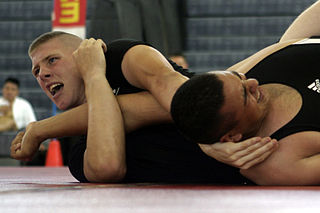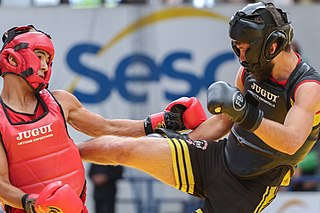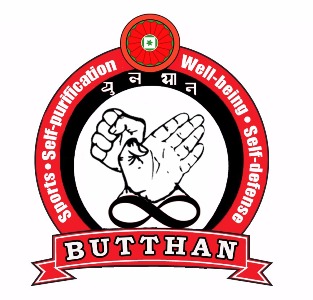
Grappling is a fighting technique as well as a full-contact combat sport based on throws, trips, sweeps, clinch fighting, ground fighting and submission holds.
Martial arts are codified systems and traditions of combat practiced for a number of reasons such as self-defense; military and law enforcement applications; competition; physical, mental, and spiritual development; entertainment; and the preservation of a nation's intangible cultural heritage.

Gatka is a form of martial art associated primarily with the Sikhs of the Punjab and other related ethnic groups, such as Hindkowans. It is a style of stick-fighting, with wooden sticks intended to simulate swords. The Punjabi name, gatka, refers to the wooden stick used and this term might have originated as a diminutive of a Sanskrit word, gada, meaning "mace".

Submission wrestling, also known as submission grappling, submission fighting or simply grappling, is a competitive martial art and combat sport that focuses on ground fighting and submission techniques. It is a hybrid discipline that incorporates elements of various grappling arts, mostly Brazilian jiu-jitsu but also Judo, Sambo, and wrestling. Submission wrestling is practiced both as a competitive sport and as a training method for self-defence and mixed martial arts (MMA).

Sanda, formerly Sanshou, also known as Chinese boxing or Chinese kickboxing, is the official Chinese kickboxing full-contact combat sport. Sanda is a fighting system which was originally developed by the Chinese military based upon the study and practices of traditional kung fu and modern combat fighting techniques; it combines boxing and full-contact kickboxing, which includes close range and rapid successive punches and kicks, with wrestling, takedowns, throws, sweeps, kick catches, and in some competitions, even elbow and knee strikes.

Sambo is a martial art with Soviet origins, an internationally practiced combat sport, and a recognized style of amateur wrestling included by UWW in the World Wrestling Championships along with Greco-Roman wrestling and freestyle wrestling.

Stick-fighting, stickfighting, or stick fighting, is a variety of martial arts which use simple long, slender, blunt, hand-held, generally wooden "sticks" for fighting, such as a gun staff, bō, jō, walking stick, baston, arnis sticks or similar weapons. Some techniques can also be used with a sturdy umbrella or even with a sword or dagger in its scabbard.

There are a number of martial arts styles and schools of Russian origin. Traditional Russian fist fighting has existed since the 1st millennium AD. It was outlawed in the Russian Empire in 1832. However, it has seen a resurgence after the break-up of the Soviet Union.

Lathi khela is a traditional Bengali martial art – a kind of stick fighting practised in India and Bangladesh. A practitioner is known as a lathial. Lathi khela originated from the Bengal region in Indian subcontinent.
A joint lock is a grappling technique involving manipulation of an opponent's joints in such a way that the joints reach their maximal degree of motion and hyperextension.

Pehlwani, also known as Kushti, is a form of wrestling contested in the Indian subcontinent. It was developed in the Mughal Empire by combining Persian Koshti pahlevani with influences from native Indian Malla-yuddha. The words pehlwani and kushti derive from the Persian terms pahlavani (heroic) and koshti respectively, meaning Heroic wrestling. A practitioner of this sport is referred to as a pehlwan while teachers are known as ustad.
Indian martial arts refers to the fighting systems of the Indian subcontinent. A variety of terms are used for the English phrases "Indian martial arts", deriving from ancient sources. While they may seem to imply specific disciplines, by Classical times they were used generically for all fighting systems.

The culture of Bengal defines the cultural heritage of the Bengalis or Bangali people native to eastern regions of the Indian subcontinent, mainly what is today the independent state of Bangladesh and the Indian states of West Bengal, Tripura, Assam and Jharkhand, where the Bengali (Bangla) language is the national, the official and the additional official language. The Bengal has a recorded history of 3,100 years.

Boli Khela or Bali Khela is a traditional form of wrestling in Bangladesh, particularly popular in the Chittagong area considered as a national game of the district. It is a form of combat sport involving grappling type techniques such as clinch fighting, throws and takedowns, joint locks, pins and other grappling holds. It is one of the oldest traditions of the Chittagong. The sporting event, held in the first month of the Bengali year date of 7th, always takes place at Madarsha Union as Mokkaro boli khela & same month date of 12th, always takes place at Laldighi Maidan as Jabbarer Boli khela.
Sport in Bangladesh is a popular form of entertainment as well as an essential part of Bangladeshi culture. Cricket is the most popular sport in Bangladesh followed by football. Ha-du-du is the national sport of Bangladesh.

Mak Yuree also known as Vajramunee, is the founder of Vajrapran and Butthan movement, the South Asian combat sports and system of personal development with the aim to obtain body-mind balance. He was selected and featured as one of the top five superhumans of the planet in the strength category by a team of scientists from the Discovery Channel in 2013. Yuree is cited as 'one of the world's most unique martial artists, a foremost authority in the field of mind training, meditation, motivational speaking and art of self-defense.' He is a Bangladeshi born Grandmaster, known for his extraordinary ability to engage highest percentage (96%) of muscles in the world through meditation. He is a 10th degree black belt holder and the President of the World Combat Self Defense Federation and Secretary General of International Butthan Federation. He went on to become the Grandmaster of the year 2007 at World Martial Arts Hall of Fame.

Mokkar Boli Khela is a special type of wrestling game, which is held in Madarsha Union under Chittagong Satkania Upazila every year on 07th Baishakh of Bengali year. The participants in this game are called "Bali". In the regional language of Chittagong, it is known as Bali khela.

There are a variety of traditional rural games in the historical region of Bengal. These games are typically played outside with very limited resources. Many of them have similarities to other traditional South Asian games. Nowadays, with urbanization, many traditional games are being played less and less.

Butthan is a Bangladeshi martial art and combat sport. It is a system of self-defense and personal development rooted in South Asian heritage. Butthan has been developed by Mak Yuree, an internationally acclaimed Grandmaster and known as Superhuman as dubbed by the Discovery Channel. It has been described as the ‘noble art of stopping-fight and enlightenment that produces physical, mental and spiritual balance’. Butthan was approved as a national sport of Bangladesh by the National Sports Council, Ministry of Youth and Sports in Bangladesh in 2013. As a combat sport, the martial art is practiced in different parts of the world under the International Butthan Federation.
Lal Dighi is one of the traditional places in Chittagong city of Bangladesh. Its location is at the end of Jail Road in the city. Lal Dighi is spread over an area of 2.70 acres. On one side of it is Andarkilla. Around it are district council buildings and local bank branches. It belongs to Ward No. 32 of Chittagong City Corporation.














